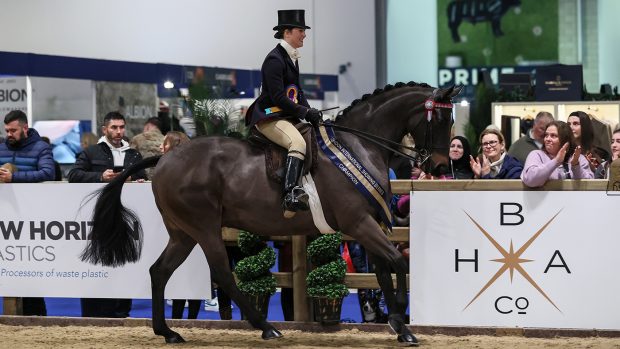Judges have to act to help combat equine obesity in the show ring – although “fantastic” progress has been made in turning the tide in this crucial welfare issue.
Representatives of showing organisations and societies, as well as judges, vets and other professionals, met at the Royal International Horse Show on 24 July to discuss the progress of the Weigh to Win scheme.
H&H has reported on the Horse Trust initiative, under which horses and ponies judged to be in the healthiest body condition are given special awards. From small beginnings in 2019, the scheme is now in operation at events from local shows to the top level.
Rachael Holdsworth, who looks after PR for the Weigh to Win scheme, updated all those present on its progress; awards were given at 20 shows in 2023 but 23 this year until the meeting, and at an average 12 classes per show, up from 8.5 last year.
There has also been a training day, at the Horse Trust, at which delegates assessed horses’ body condition scores and looked at ultrasound imaging to see where fat was deposited, and increased use of social media to help spread the word.
Ms Holdsworth said score sheets are assessed, which help give a picture of the situation across the country.
“I believe it’s looking positive – but we need more data,” she said, adding that award winners can also help with this by scanning the QR code on rosettes to input information, background and feedback.
“We get lots of comments from people who really appreciate the award, and really care about the wellbeing of their horses,” she said.
The aim is to keep increasing the number of shows involved and improve communication, ensuring that the scheme’s message is a positive one. A body condition-scoring (BCS) accreditation certificate was suggested, and collaboration and communication is key.
“We know the horse and its wellbeing is our first priority and with the cooperation of everyone, hopefully we can look at a better future,” Ms Holdsworth said.
British Show Pony Society chair Paul Cook said the society had been covering the issue at judges’ and members’ conferences, at which it had been well received. Jan Rogers of the Horse Trust encouraged other societies to follow suit, adding that she and researcher Tamzin Furtado, the drivers behind the scheme, are happy to present live or online.
British Equine Veterinary Association council member Imogen Burrows said she spoke at a Coloured Horse and Pony Society (CHAPS) judges’ conference and ran a BCS workshop.
“It felt a bit like jumping into the fire at times,” she said. “But it was really productive. Interestingly, the most conflict came from the youngest judges; it was interesting to see where some of the myths originated, and it wasn’t the older ones. There was some vehement discussion.”
Mr Cook said judging has changed from his early experience.
“Then, people were from an equestrian background and had much other experience but many judges now, their only experience is showing,” he said. “They haven’t evented or hunted, and come in with a narrow view.”
CHAPS board member Richi Grace asked whether the 0-5 BCS system used was too much as a “one size fits all” method, adding that some horses “generally carry more weight than others”.
But Dr Furtado said: “There is no reason show horses should be fatter and need their own scoring system. It looks at the fat they carry, so you can use the same system for a maxi cob and a thoroughbred. It can be used in any situation, and that’s absolutely what we see in training. We’re trying to change the perception that a show horse has to be fat.”
The issue of some judges saying horses “need more condition” was raised, and the fact that although they may mean more muscle, it can be interpreted as more weight.
Dr Furtado and Ms Rogers said award winners had told them judges had said this, even for young horses.
“Things are moving in the right direction,” Dr Furtado said. “We’re getting fewer judges who want to see fat horses, which is brilliant, and producers’ horses are often winning the awards, so they’re producing them fitter.
“But we have to be careful with language; if a judge means the horse needs more muscle, they need to say that. I’d like organisations to say it’s not acceptable to tell people to put more weight on their horses.”
Judge David Bartram-Lawton added: “We should judge conformation and bone, it doesn’t have to be covered in a lot of flesh. But judges are nervous about putting the fat horse that’s won everything down; unless we educate judges, we’ll have the same fat horses winning everything.
“We as judges are the only ones who can do anything about it. We’re judging conformation and way of going and just because they’re covered in fat, it doesn’t make them better animals.”
Showing Council chair Liz Inman added that the scheme has been “fantastic” but there is “still a long way to go”.
“It’s all about education and communication,” she said.
- To stay up to date with all the breaking news throughout the Olympic Games, Burghley, Horse of the Year Show and more, subscribe to the Horse & Hound website
You might also be interested in:

‘This issue is not going away’: new measures in the fight against equine obesity

‘It sounds like hocus pocus’ but hypnotic gastric band and therapy help rider lose seven and a half stone in a year

Happy, healthy horses the aim of ‘eye-opening’ training to help combat equine obesity

Subscribe to Horse & Hound magazine today – and enjoy unlimited website access all year round





